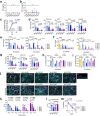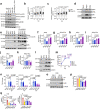Evolution of enhanced innate immune suppression by SARS-CoV-2 Omicron subvariants
- PMID: 38228858
- PMCID: PMC10847042
- DOI: 10.1038/s41564-023-01588-4
Evolution of enhanced innate immune suppression by SARS-CoV-2 Omicron subvariants
Abstract
Severe acute respiratory syndrome coronavirus 2 (SARS-CoV-2) human adaptation resulted in distinct lineages with enhanced transmissibility called variants of concern (VOCs). Omicron is the first VOC to evolve distinct globally dominant subvariants. Here we compared their replication in human cell lines and primary airway cultures and measured host responses to infection. We discovered that subvariants BA.4 and BA.5 have improved their suppression of innate immunity when compared with earlier subvariants BA.1 and BA.2. Similarly, more recent subvariants (BA.2.75 and XBB lineages) also triggered reduced innate immune activation. This correlated with increased expression of viral innate antagonists Orf6 and nucleocapsid, reminiscent of VOCs Alpha to Delta. Increased Orf6 levels suppressed host innate responses to infection by decreasing IRF3 and STAT1 signalling measured by transcription factor phosphorylation and nuclear translocation. Our data suggest that convergent evolution of enhanced innate immune antagonist expression is a common pathway of human adaptation and link Omicron subvariant dominance to improved innate immune evasion.
© 2024. The Author(s).
Conflict of interest statement
The authors declare no competing interests.
Figures











References
MeSH terms
Grants and funding
- MR/S023380/1/MRC_/Medical Research Council/United Kingdom
- MR/W005611/1/MRC_/Medical Research Council/United Kingdom
- MR/Y004205/1/MRC_/Medical Research Council/United Kingdom
- 223065/WT_/Wellcome Trust/United Kingdom
- MC_UU_00034/3/MRC_/Medical Research Council/United Kingdom
- 220863/WT_/Wellcome Trust/United Kingdom
- MC_PC_19026/MRC_/Medical Research Council/United Kingdom
- MC_UU_00034/8/MRC_/Medical Research Council/United Kingdom
- MC_UU_12014/2/MRC_/Medical Research Council/United Kingdom
- MC_UU_00034/9/MRC_/Medical Research Council/United Kingdom
- WT_/Wellcome Trust/United Kingdom
LinkOut - more resources
Full Text Sources
Medical
Research Materials
Miscellaneous

